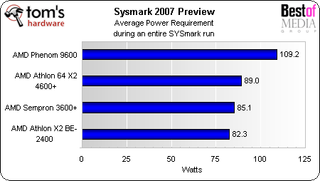AMD CPU Efficiency Compared
Total Power Required For SYSmark 2007 Preview

The total power required to complete an entire SYSmark 2007 run is highly interesting. It displays the power requirement in watt-hours for the entire test system (without the display). Phenom required the most power and the Athlon X2 BE-2400 the least, which can be explained by their minimum and maximum power requirements. The same applies to the Sempron: it is not the fastest processor around, so it has to work at high loads most of the time, causing power requirements to skyrocket. This is an excellent example to illustrate that a processor that is technically efficient when looking at min/max power requirement numbers isn't necessarily efficient under certain workload conditions. If the processor is slow enough, it will require much more time to get the job done, requiring more power during this activity period.
SYSmark Score Per Watt-hour

We explored the relation between the SYSmark score and the power required to complete the benchmark. Clearly, Phenom offers an even better SYSmark score per watt than the high efficiency Athlon X2 BE-2400. Knowing that the minimum and maximum power requirements of Phenom are significantly higher than those of the efficient Athlon X2 processor, the result seems amazing. In fact it is, because it proves that Phenom does indeed provide significantly more performance thanks to its four cores and L3 cache design. Clearly, if you want to have a processor to work on huge workloads rather than having it sit idle, the Phenom quad core is the much better product compared to the dual core Athlons. The upcoming triple cores should also score well in this test, as the unused cores should reduce the idle power requirements, while three instead of four cores might not have too much of an impact on workload benchmarks such as SYSmark 2007. We'll look into this once the Phenom 8000 triple cores become available.
Stay on the Cutting Edge
Join the experts who read Tom's Hardware for the inside track on enthusiast PC tech news — and have for over 25 years. We'll send breaking news and in-depth reviews of CPUs, GPUs, AI, maker hardware and more straight to your inbox.
Current page: Total Power Required For SYSmark 2007 Preview
Prev Page Power Requirement Results Next Page Performance Per Watt NormalizedMost Popular

